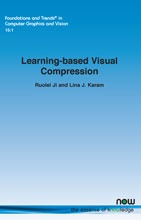Learning-based Visual Compression
By Ruolei Ji, Arizona State University, USA, ruoleiji@asu.edu | Lina J. Karam, Lebanese American University, Lebanon, and Arizona State University, USA, lina.karam@lau.edu.lb
Abstract
Visual compression is an application of data compression to lower the storage and/or transmission requirements for digital images and videos. Due to the rapid growth in visual data transmission demand, more efficient compression algorithms are needed. Considering that deep learning techniques have successfully revolutionized many visual tasks, learning-based compression algorithms have been explored over the years and have been shown to be able to outperform many conventional compression methods. This survey provides a review of various visual compression algorithms, both end-to-end learning-based image compression approaches and hybrid image compression approaches. Some learningbased video compression methods are also discussed. In addition to describing a wide range of learning-based image compression approaches that have been developed in recent years, the survey describes widely used datasets, presents recent standardization efforts, and discusses potential research directions.
Learning-based Visual Compression
In recent years, the demand for visual media has been growing exponentially. Among the large amount of visual traffic over the Internet, high-resolution visual content constitutes an increasingly large percentage. With such a rapid growth of digital visual media traffic, there is a growing need for image/video compression approaches that can achieve much higher compression ratios than the ones obtained using existing conventional image/video compression methods, while maintaining a high visual quality.
Visual compression is an application of data compression to lower the storage and/or transmission requirements for digital images and videos. Due to the rapid growth in visual data transmission demand, more efficient compression algorithms are needed. Considering that deep learning techniques have successfully revolutionized many visual tasks, learning-based compression algorithms have been explored over the years and have been shown to be able to outperform many conventional compression methods.
This monograph provides a review of various visual compression algorithms, both end-to-end learning-based image compression approaches and hybrid image compression approaches. Some learning-based video compression methods are also discussed. In addition to describing a wide range of learning-based image compression approaches that have been developed in recent years, the survey describes widely used datasets, and discusses potential research directions.
